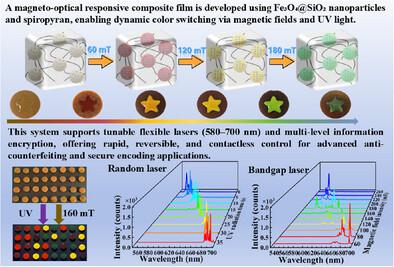Magnetic Photonic Crystal for Adaptive Flexible Lasers and Secure Encoding
IF 10
1区 物理与天体物理
Q1 OPTICS
引用次数: 0
Abstract
Responsive photonic crystals (PCs) are attractive because of their unique photonic bandgap (PBG) effect, but existing systems tend to have challenges such as narrow PBG tuning range, slow response to external stimuli, poor reversibility, and difficulty in device integration. To address these issues, magneto-responsive colloidal PCs have been developed with the advantages of fast response, high sensitivity, good reversibility, and contactless manipulation. In addition, magneto-optical responsive flexible lasers are developed to bring new solutions for information encryption and anti-counterfeiting. Combining magnetic nanoparticles and spiropyran molecules to create a composite film that can be both magnetically and optically color-changing, achieving non-contact, multi-stimulus-responsive color-changing, and expanding the application fields for color display and anti-counterfeiting technologies. Further, a flexible laser is designed that achieves efficient and reversible laser wavelength tuning from 580 to 700 nm through dual control of the förster resonance energy transfer effect and magnetic field and UV irradiation. This laser's wavelength tuning combines the structural regulation of magnetic particles with the photo-responsive properties of spiropyran. It not only advances the field of optical communication but also enhances the security of information encoding and anti-counterfeiting through the synergy of magneto- and photochromism, bringing revolutionary improvements to anti-counterfeiting technology.

磁光子晶体用于自适应柔性激光器和安全编码
响应光子晶体(Responsive photonic crystals, pc)因其独特的光子带隙(PBG)效应而备受关注,但现有系统往往存在PBG调谐范围窄、对外部刺激响应慢、可逆性差以及器件集成困难等问题。为了解决这些问题,磁响应胶体pc具有响应快、灵敏度高、可逆性好和非接触式操作等优点。此外,还开发了磁光响应柔性激光器,为信息加密和防伪带来新的解决方案。将磁性纳米颗粒与螺吡喃分子相结合,制备出兼具磁性和光学变色的复合薄膜,实现非接触、多刺激响应式变色,拓展了彩色显示和防伪技术的应用领域。此外,设计了一种柔性激光器,通过förster共振能量传递效应和磁场和紫外线照射的双重控制,实现了580 ~ 700 nm的高效可逆激光波长调谐。这种激光器的波长调谐结合了磁性粒子的结构调节和螺吡喃的光响应特性。它不仅推动了光通信领域的发展,而且通过磁致变色和光致变色的协同作用,提高了信息编码和防伪的安全性,给防伪技术带来了革命性的进步。
本文章由计算机程序翻译,如有差异,请以英文原文为准。
求助全文
约1分钟内获得全文
求助全文
来源期刊
CiteScore
14.20
自引率
5.50%
发文量
314
审稿时长
2 months
期刊介绍:
Laser & Photonics Reviews is a reputable journal that publishes high-quality Reviews, original Research Articles, and Perspectives in the field of photonics and optics. It covers both theoretical and experimental aspects, including recent groundbreaking research, specific advancements, and innovative applications.
As evidence of its impact and recognition, Laser & Photonics Reviews boasts a remarkable 2022 Impact Factor of 11.0, according to the Journal Citation Reports from Clarivate Analytics (2023). Moreover, it holds impressive rankings in the InCites Journal Citation Reports: in 2021, it was ranked 6th out of 101 in the field of Optics, 15th out of 161 in Applied Physics, and 12th out of 69 in Condensed Matter Physics.
The journal uses the ISSN numbers 1863-8880 for print and 1863-8899 for online publications.

 求助内容:
求助内容: 应助结果提醒方式:
应助结果提醒方式:


